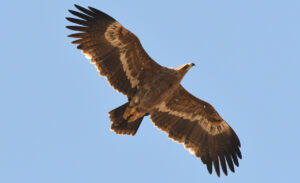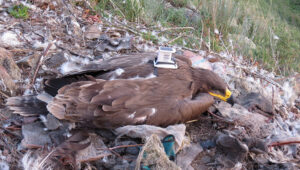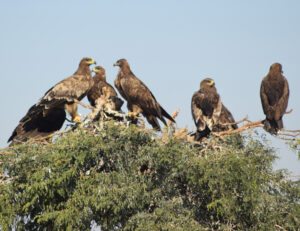Third International Scientific and Practical Conference “Eagles of the Palearctic: Study and Conservation”
Raptors Conservation. Suppl. 2. Proceedings of Conferences
Data on remote tracking of Steppe Eagles breeding in Daurian steppe (Russia, China): migration, wintering
Zaitsev I.S. (Daursky State Nature Biosphere Reserve, Nizhny Tsasuchei, Russia)
Goroshko O.A. (Daursky State Nature Biosphere Reserve; Chita Institute of Nature Resources, Ecology and Cryology, Chita, Russia)
Huashan D., Songtao L. (Hulun Lake National Nature Biosphere Reserve, Hailar, China)
Contact:
Ivan Zaitsev zaitsev-student@mail.ru
Oleg Goroshko oleggoroshko@mail.ru
Dou Huashan douhuashan@163.com
Liu Songtao 398861907@qq.com
Recommended citation: Zaitsev I.S., Goroshko O.A., Huashan D., Songtao L. Data on Remote Tracking of Steppe Eagles Breeding in Daurian Steppe (Russia, China): Migration, Wintering. – Raptors Conservation. 2023. S2: 242–246. DOI: 10.19074/1814-8654-2023-2-242-246 URL: http://rrrcn.ru/en/archives/35047
) were tagged by GPS/GSM trackers as nestlings in Russian part of the transboundary Daurian steppe in south-east of Transbaikalia (Zabaykalsky Krai): 4 birds in 2019, and 6 in 2020. Additionally, one juvenile from the same population, (transmitter # 079) was released from rehabilitation center (Khailar City, Inner Mongolia, China) in August 2022; this bird successfully returned to the Khailar River in Chinese part of the Daurian steppe in 2023, where transmitter stopped working on 21/05/2023. Four birds tracked in Russia, successfully completed first autumn migration but later their signals were lost on wintering sites (# 103, 106, 135, 152). The transmission from other eagles ceased at different stages of the first autumn migration: two on the northeastern edge of the Tibetan Plateau, one in the Lössov Plateau, one on the Qinllin Mountain Range, one 130 km east of the Taihanshan Range, and one on the northern edges of the Taihanshan Range. To our knowledge 4 birds died in agricultural fields in China, India, Nepal, and Myanmar presumably due to pesticide poisoning; 2 birds died of unknown causes; 5 transmitters broke down. Other possible causes of mass death of steppe eagles on wintering sites in India and Nepal are known from literature: diclofenac poisoning after feeding on carcasses of diseased livestock, and electrocution on power lines. The tracked eagles didn’t visit carcass disposal sites and landfills and didn’t perch on power lines. Although we don’t exclude possibility of eagles feeding on solitary dead cows away from disposal sites and landfills.
Tracking revealed two wintering sites distant from each other by 1400 km: Nepal and contiguous areas of India (# 103, 135, 152) and central Myanmar (# 106, 079). The main part of the migration corridor is the same for both. The corridor is curved in an eastwards direction probably because eagles avoid migrating directly across the vast flat Mongolian steppe, they prefer to fly along mountain ranges where strong thermal streams exist, which are necessary to support the soaring flight of eagles. In the fall, eagles fly from Dauria southward along the Great Khingan mountains (some of them cross it), then turn southwestward to the north-eastern part of the Tibet Plateau. At this point, # 135 crossed the Tibetan Plateau in a southeastern direction straight to Nepal, but all other eagles flew south over the eastern margins of the plateau to the border with Myanmar; and here the migration paths split: # 079 and # 106 continued in the same direction to wintering grounds in Myanmar, while # 103 and # 152 turned westward and moved along the Himalayan Mountains to wintering grounds in Nepal.
Fall migration begun, on average, on 03/10 (15/09–15/10) and finished on 26/11 (11/11–17/12). Durations of autumn migration on the Nepal–Indian flyway was 49 and 74 days (# 152, 103), # 152 made 52 stops on which he spent 84% of migration time (data from other trackers are not detailed enough due to poor transmitting). Durations of fall migration on the Myanmar flyway (# 106, 079) was 42 and 52 days, with 31 and 34 stops that covered 83% and 80% of migration time respectively. Total length of the Nepal–Indian flyway (# 103, 135, 152) excluding local flights within stopover sites was on average 5323 km (4980–5618), speed on average 103.94 km per day (75.9–134.2). For the Myanmar flyway (# 106, 079) length was 4300 km and 5609 km, average speed 82.6 km per day and 133.5 km per day. Only a single track of spring migration was acquired (# 079): start on 27.03, finish on 18.05 (85 kilometers north of Hailar City), total duration of migration 52 days, length 4604 km, average speed 88.5 km per day, the bird made 21 stops and spent there 88% of migration time.
Eagle # 135 started wintering in northern India, 40 km from border with Nepal (E 79.76; N 28.87), but soon the bird was dead. Two eagles wintered in Nepal about 60 km from each other: # 152 inhabited hillsides in the Rudi River basin (E 83.31; N 27.87), its main wintering range (where bird stayed about 80% of all wintering time) was 168.3 km2; # 103 preferred various rivers and hillsides in Pokhara Valley (E 83.87; N 28.24), its main wintering range was 210.8 km2. Both birds spent most of the time on various hillsides and terrace farms within the region. Both wintering sites in Myanmar separated by about 340 km are situated within basin of the Irrawaddy River, mostly in the agricultural fields where the birds search for prey in daytime and spend overnight in hedgerows and sometimes in nearby forests. The main wintering range of # 106 (E 95.88; N 23.82) was 448.74 km2, № 079 (E 94.86; N 20.94) – 1106,1 км2.



